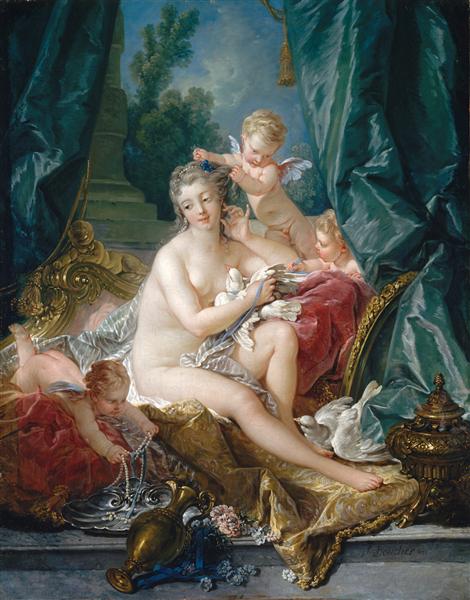
Rococo
Style
The term "rococo" was first used by Jean Mondon in his Premier Livre de forme rocquaille et cartel (First book of Rococo Form and Setting) (1736), with illustrations that depicted the style used in architecture and interior design. The term was derived from the French rocaille, meaning "shell work, pebble-work," used to describe High Renaissance fountains or garden grottos that used seashells and pebbles, embedded in stucco, to create an elaborate decorative effect. This light, sensuous, intensely decorative style developed in France in the early 18th century following the death of Louis XIV and in reaction to the Baroque grandeur of Versailles.
Rococo art and architecture carried a strong sense of theatricality and drama, influenced by stage design. Theater's influence could be seen in the innovative ways painting and decorative objects were woven into various environments, creating fully immersive atmospheres. Detail-work also flourished in the Rococo period. Stucco reliefs as frames, asymmetrical patterns involving motifs and scrollwork, sculptural arabesque details, gilding, pastels, and tromp l'oeil are the most noted methods that were used to achieve seamless integration of art and architecture.
Genre paintings were popular ways to represent the Rococo period's bold and joyous lust for life. This included fete galante, or works denoting outdoor pastimes, erotic paintings alive with a sense of whimsical hedonism, Arcadian landscapes, and the "celebrity" portrait, which positioned ordinary people in the roles of notable historical or allegorical characters. French Rococo painting, in general, was characterized by easygoing, lighthearted treatments of mythological and courtship themes, rich and delicate brushwork, a relatively light tonal key, and sensuous coloring. Rococo sculpture was notable for its intimate scale, its naturalism, and its varied surface effects. Characterized by elegance, levity, floral motifs, muted colors, and curving, asymmetrical lines, Rococo painting combined this aesthetic with themes of sensual love and nature. The style quickly spread to the rest of France, and then to Germany, Austria, England, and other European countries.
In the 1730s, Rococo style spread to the Catholic German-speaking lands, where it was adapted to a brilliant style of religious architecture that combined French elegance with south German fantasy as well as with a lingering Baroque interest in dramatic spatial and plastic effects. In Italy the Rococo style was concentrated primarily in Venice, where it was epitomized by the large-scale decorative paintings and the urban vistas. Meanwhile, in France the style had already begun to decline by the 1750s when it came under attack from critics for its triviality and ornamental excesses, and by the 1760s the new, more austere style of Neoclassicism began to supplant the Rococo in France.
In Great Britain, rococo was called the "French taste" and had less influence on the design and the decorative arts than in continental Europe, although its influence was felt in such areas as silverwork, porcelain, and silks. Without becoming flamboyant, a new, lighter look infused English art.
The Rococo crossed the Atlantic via three principal means: engraved designs in print series and books, imported objects, and immigrant artisans. The American adoption of the Rococo focused almost exclusively on the style’s ornamental motifs—shells and rocailles, scrollwork, acanthus leaves, and other flora and fauna, often in symmetrical compositions. These were enthusiastically applied, by many leading urban craftsmen, to architectural interiors, engravings, silver, furniture, and other domestic equipage.
See also Rococo (art movement)
Sources:
www.theartstory.org
Wikipedia:
https://en.wikipedia.org/wiki/Rococo


